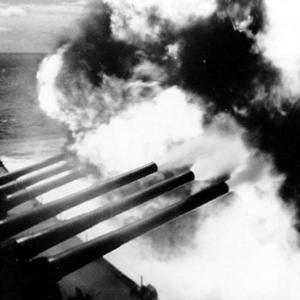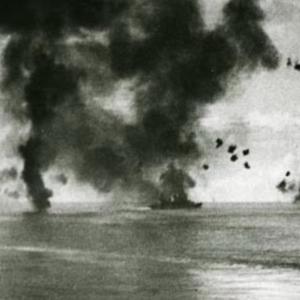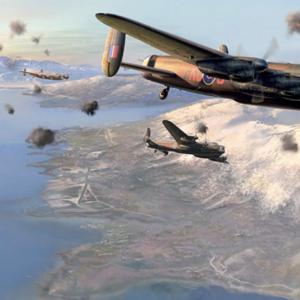
Bismarck battleship
The German battleship Bismarck was one of the most powerful warships ever built by Nazi Germany and symbolized the nation’s attempt to challenge British naval dominance during World War II. Named after Otto von Bismarck, the ship was the lead vessel of its class and a centerpiece of the Kriegsmarine.
Bismarck was designed by Dr. Hermann Burckhardt and the Kriegsmarine’s shipbuilding bureau, with oversight from the Oberkommando der Marine (OKM). Although Germany was officially bound by naval treaties such as the Treaty of Versailles and later the Washington Naval Treaty, the Bismarck far exceeded those limits in practice. While officially listed at around 35,000 tons, its full displacement when fully loaded exceeded 50,000 tons.
The ship measured 251 meters in length, with a beam of 36 meters and a draft of 10.2 meters. It was capable of reaching speeds over 30 knots (approximately 55.7 km/h) and had a maximum range of 8,870 nautical miles at a cruising speed of 19 knots. Bismarck was heavily armored, with belt armor up to 320 mm thick and deck armor ranging from 50 to 120 mm, providing formidable protection against gunfire and torpedoes.
Bismarck was constructed at the Blohm & Voss shipyard in Hamburg. Its keel was laid on July 1, 1936. The ship was launched on February 14, 1939, and officially commissioned into the German Navy on August 24, 1940. At the time of its launch, Bismarck was among the most advanced and formidable battleships in existence.
Bismarck had a crew of approximately 2,200 officers and enlisted men. While life aboard the ship was relatively comfortable compared to older warships, life during its only mission was intense, demanding constant alertness and readiness for combat.
The ship was under the command of Captain Ernst Lindemann during its sole voyage. Fleet Admiral Günther Lütjens also sailed aboard the Bismarck as the senior commanding officer for the mission known as Operation Rheinübung.
Bismarck’s main battery consisted of eight 38 cm (15-inch) SK C/34 naval guns, mounted in four twin turrets named Anton, Bruno, Caesar, and Dora. These massive guns could fire shells weighing approximately 800 kilograms to a range of 35 kilometers, making them among the most powerful naval guns of the war.
Its secondary battery included twelve 15 cm (5.9-inch) SK C/28 guns, located in six twin turrets. For anti-aircraft defense, Bismarck was equipped with a range of weapons: sixteen 10.5 cm (4.1-inch) SK C/33 guns, sixteen 3.7 cm (1.5-inch) guns, and twelve 2 cm (0.79-inch) Flak guns. These weapons offered substantial protection from air attacks, although they were less effective against coordinated Allied air assaults.
The ship was also fitted with advanced radar and fire-control systems for its time, including Seetakt radar, which assisted in locating and tracking enemy ships, especially in poor weather or low visibility. However, compared to British and American radar systems, Bismarck’s technology was less sophisticated and offered more limited range and detail.
Bismarck’s only operation was Operation Rheinübung, which began on May 18, 1941. The plan was for Bismarck and the heavy cruiser Prinz Eugen to break into the Atlantic and attack Allied shipping convoys. This operation was part of a broader German strategy to strangle Britain by disrupting the flow of supplies from North America.
On May 24, 1941, Bismarck encountered the British battlecruiser HMS Hood and the battleship HMS Prince of Wales in the Denmark Strait. In a short but fierce engagement, Bismarck sank the Hood with a massive shell that ignited one of its magazines, causing a catastrophic explosion. The Hood sank in minutes, taking 1,415 of its 1,418 crew with it. Prince of Wales was damaged and forced to retreat. Bismarck had sustained some hits but remained operational.
The sinking of Hood shocked the British public and military, prompting the Royal Navy to launch a massive operation to hunt down and destroy Bismarck. Over 50 ships, including aircraft carriers, cruisers, destroyers, and battleships, were deployed in the pursuit.
On May 26, 1941, aircraft from the carrier HMS Ark Royal launched a torpedo attack. One torpedo struck Bismarck in the stern, jamming its rudder and rendering the ship nearly unsteerable. Unable to escape, Bismarck was surrounded by British forces the next day.
On the morning of May 27, 1941, British battleships HMS King George V and HMS Rodney opened fire. In a brutal two-hour battle, Bismarck was hit by hundreds of shells. Fires broke out across the ship, most of its main guns were silenced, and it began taking on water. Despite its thick armor, Bismarck was overwhelmed.
At around 10:39 a.m., the German crew began scuttling the ship to prevent its capture. Torpedoes from British destroyers hastened the sinking. Bismarck finally went down in the Atlantic Ocean approximately 650 kilometers west of Brest, France. Of the approximately 2,200 crew members, only 114 survived.
The brief but dramatic life of the Bismarck left a significant legacy in naval warfare. It highlighted the potential of battleships as devastating surface raiders, but also revealed their vulnerability to air power and coordinated enemy fleets. The operation was the last major surface raid by the German Navy in the Atlantic, signaling a shift toward submarine warfare and marking the end of Germany’s ambitions for naval supremacy on the high seas.
The wreck of the Bismarck was discovered in 1989 by Dr. Robert Ballard, the same oceanographer who found the Titanic. It rests at a depth of nearly 4,800 meters beneath the Atlantic, a powerful reminder of a warship that once shook the world.










